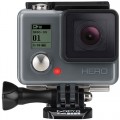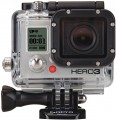Connection
—
GPS module. Built-in satellite navigation module that allows you to determine the current coordinates of the device. Options for using data from GPS can be different: geotagging footage, recording travelled routes, determining the speed of movement, or even full-fledged navigation on the map.
—
Wi-Fi module. The Wi-Fi wireless module in action cameras can be used in different formats: in some models, it is responsible for connecting to the Internet, in others it is for communicating with a smartphone or other gadget, in others both options are available at once. Anyway, the main use of this connection is to transfer footage to an external device or to the Internet (including broadcasting in the online streaming format, see “Filming capabilities”). In addition, more specific functions can be provided, for example, using a smartphone as an external viewfinder and remote control. Specific features of the use of Wi-Fi in each case should be clarified separately.
—
Bluetooth. Direct wireless communication technology for exchanging information between two electronic devices. In action cameras, it is most often used to connect remote controls, selfie sticks and smartphones, which can also act as a remote control. Unlike the Wi-Fi module, it consumes battery power more economically, but at the same time, the range of wireless communication is reduced to 10 m
...etres.
— NFC chip. NFC is a wireless communication technology over short distances (up to 10 cm). In action cameras, this technology is mainly used as an auxiliary one, to facilitate connection with a smartphone or other gadget via Wi-Fi or Bluetooth. If such a gadget is also equipped with NFC, just bring the camera to it and confirm the connection — it's easier than fiddling with the settings.
— USB-C. A relatively new type of USB interface that uses a miniature double-sided connector, slightly larger than microUSB. Most often used for similar purposes — as a universal connector through which you can charge the battery and connect the camera to a computer (for copying photos and videos, updating software, etc.). P.). At the same time, USB-C provides a higher data transfer rate than microUSB, supports more power supply, and also has a more convenient plug. Occasionally, there are more specific ways to use this interface — for example, direct connection to a smartphone or tablet that has a USB-C port.
— HDMI output. HDMI is a digital interface specially designed for high-definition video and multi-channel audio. With this output, you can connect the camera to a TV, monitor or other device as an external player and play the footage directly. The convenience of HDMI is that almost all modern video equipment with support for HD standards is equipped with such inputs.
Note that the cameras can be equipped with a smaller version of the connector — miniHDMI or microHDMI; however, finding an adapter cable is usually not a problem, it can even be supplied in the kit.
— Microphone connection. Almost any modern action camera has a built-in microphone that allows you to record sound. However, the quality of its sound is often quite low. Thus, many models can connect an external microphone — you can fix it, for example, on the helmet strap and record the comments of the athlete in the process of movement. Note that different types of connectors can be used for such a connection. As a result, the specific connector type and supported accessories depend on the action camera model, and some devices are only compatible with branded microphones.Max. memory card capacity
The largest memory card capacity supported by the camera model.
This limitation is due to two points. First, the larger the drive, the more computing power is required to use it. Secondly, each type of memory card has its maximum capacity. For example, the capacity of an SD HC card cannot exceed 32 GB, larger drives already belong to the SD XC standard, and if it is not supported, the maximum card capacity cannot exceed 32 GB.
It is strongly not recommended to exceed the maximum allowable capacity: even if the card is recognized by the device, its normal operation is not guaranteed.
Type
All action cameras are, by definition, self-powered, but the sources used may vary:
—
Removable battery. The proprietary battery, not related to standard batteries like AA. The main advantage of this option is that the battery comes with the camera, so you do not have to spend time and money on buying a power source. Specs of original batteries can significantly exceed primary cells. However, when discharging, the only option is usually recharging, it takes quite a long time and requires an external power supply. This design has several useful features: the battery can be charged in an external charger, and another battery of the same type can be installed in the camera during the procedure.
— Non-removable battery. The proprietary battery (see above), has a non-removable design. Such batteries are generally less convenient than removable ones — they cannot be removed for charging, replaced with other batteries, etc. However, the non-removable design gives one important advantage: the camera body can be made almost integral, which has a positive effect on reliability and tightness.
—
Non-rechargeable batteries(AA / AAA). Powered by replaceable batteries of a standard size — AA or AAA. This option is convenient because when the charge is exhausted, you do not need to look for a source of electricity and wait until the charging is over — dead batteries can be replaced with ne
...w ones in just a couple of minutes. On the other hand, such a power supply is considered less suitable for action cameras than special batteries, and is quite rare, mainly in low-cost models. The main reason for this is that primary batteries are bulkier and, at the same time, less capacious than proprietary batteries, and when using them it is difficult to achieve a combination of compactness and good battery life.Battery model
The model name of the proprietary battery used in the camera. Knowing this name, you can easily find a spare or replacement battery for the device.
Capacity
The capacity of the battery supplied with the action camera.
All other things being equal, a higher capacity allows the device to last longer on a single charge. However, action cameras can differ markedly in design features and, as a result, in power consumption. Therefore, only models with similar specs can be compared with each other in terms of capacity (and even then quite approximately). To assess the autonomy of the device, it is better to use data on the actual operating time on a charge (this data can be indicated by the manufacturer itself or given in reviews).

